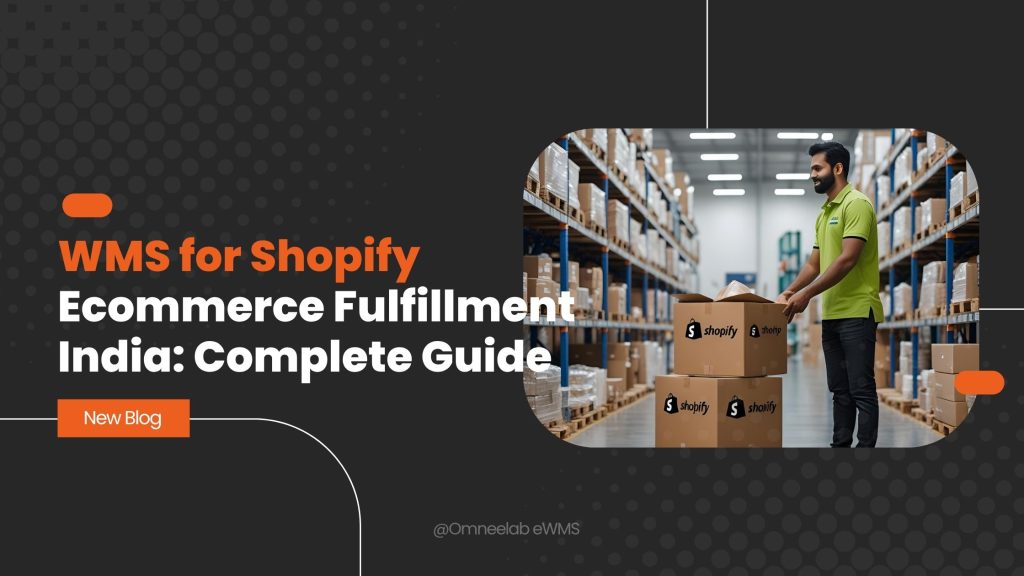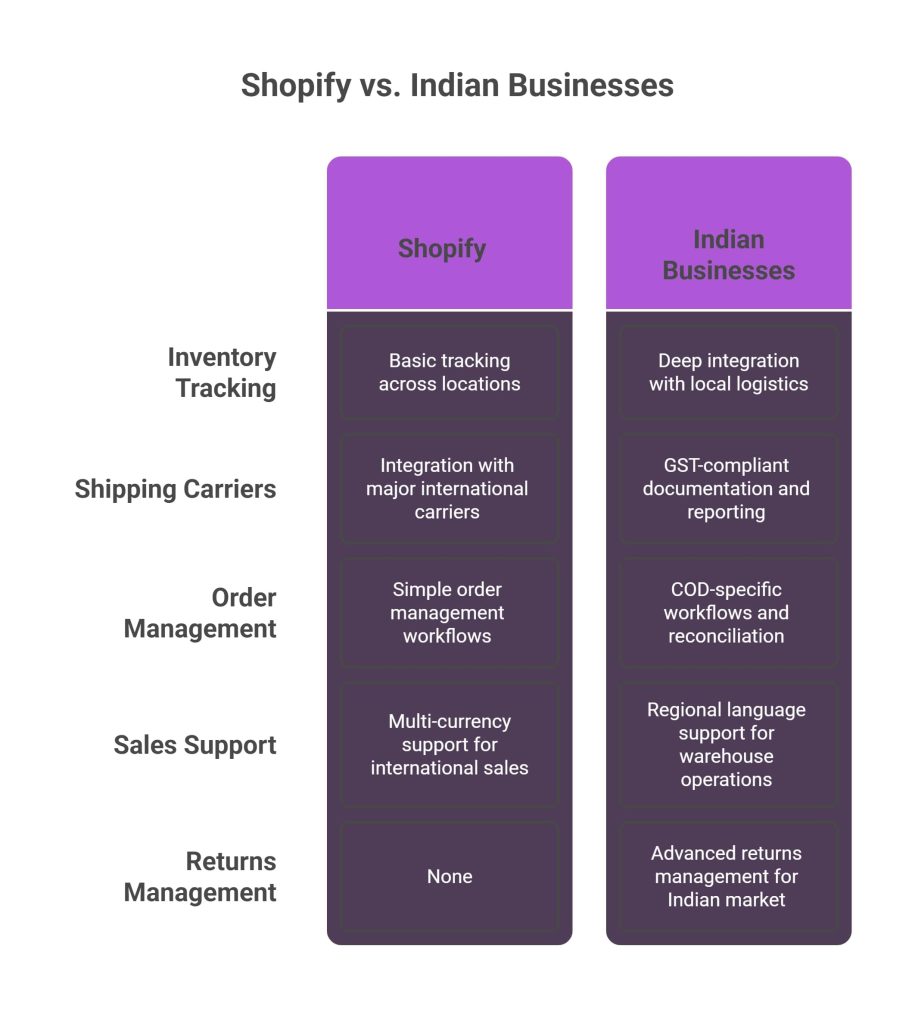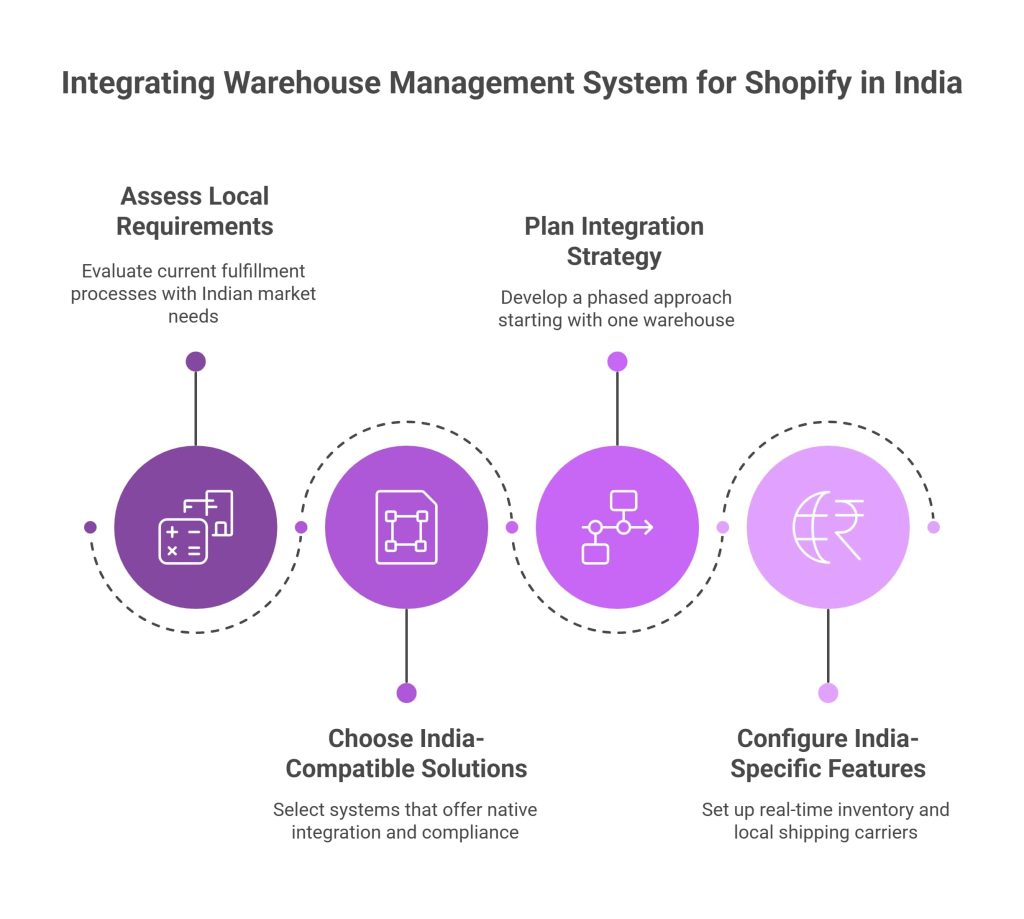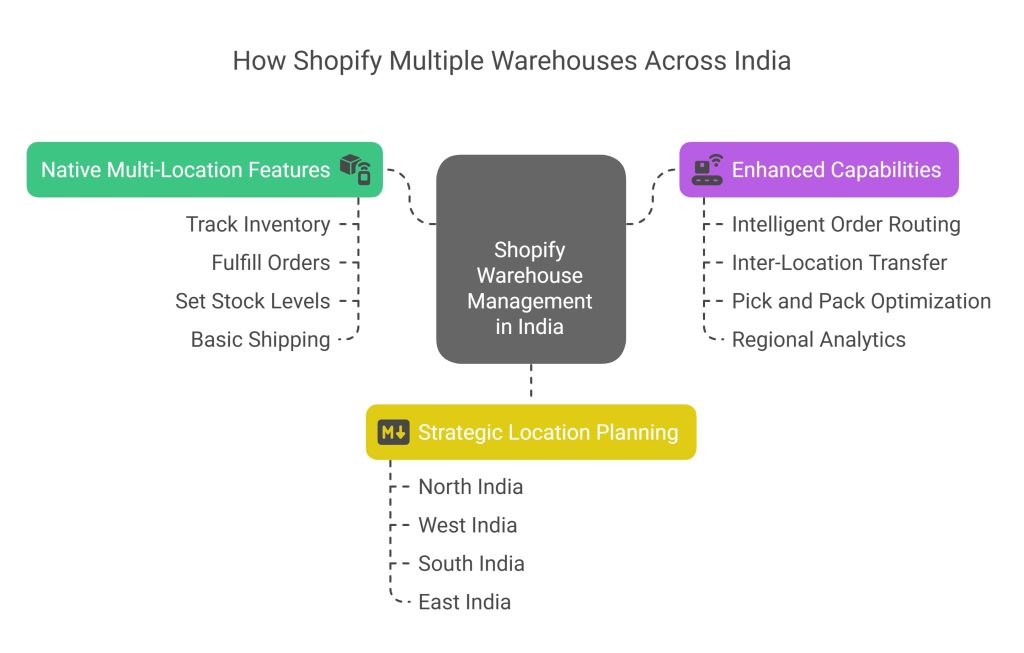India’s ecommerce landscape is exploding, and if you’re running a Shopify store in this dynamic market, you’ve probably experienced the growing pains firsthand. One day you’re managing a handful of orders manually, and the next, you’re drowning in hundreds of orders from across the country—from Mumbai to Bengaluru, Delhi to Chennai, and everywhere in between.
This is where a WMS for Shopify becomes not just helpful, but absolutely essential for Indian businesses. The unique challenges of the Indian market—from complex logistics networks to diverse customer preferences across different states—make implementing a robust Shopify warehouse management system crucial for sustainable growth.

Whether you’re a startup in Pune trying to scale nationally or an established business in Hyderabad looking to optimize operations, understanding how Shopify ecommerce fulfillment software works in the Indian context can make or break your success. The good news? The solutions available today are more sophisticated and India-friendly than ever before.
In this comprehensive guide, we’ll explore everything you need to know about implementing Shopify fulfillment solutions specifically for the Indian market, including local challenges, opportunities, and the best practices that successful Indian Shopify merchants are using right now.
The Indian Ecommerce Fulfillment Landscape
Before diving into Shopify inventory management solutions, let’s understand what makes the Indian market unique.
India’s ecommerce sector is projected to reach $200 billion by 2026, but this growth comes with distinct challenges that international solutions don’t always address.
Geographic Complexity India spans 28 states and 8 union territories, each with different languages, preferences, and logistics requirements. Your warehouse management system for Shopify needs to handle this complexity while maintaining efficiency across diverse regions.
Infrastructure Variations While metros like Mumbai and Delhi have excellent logistics infrastructure, Tier 2 and Tier 3 cities often present unique challenges. Your Shopify logistics integration must be flexible enough to work with both advanced urban networks and developing rural infrastructure.
Regulatory Compliance GST compliance, state-specific regulations, and documentation requirements make Shopify order fulfillment in India more complex than in many other markets. The right system must handle these nuances seamlessly.
Customer Expectations Indian consumers increasingly expect fast delivery, easy returns, and cash-on-delivery options. Your Shopify automated fulfillment system must accommodate these preferences while maintaining profitability.
Why Indian Businesses Need Specialized WMS Solutions
Traditional Shopify fulfillment apps often fall short when dealing with India-specific requirements. Here’s why Indian businesses need more sophisticated solutions:
Multi-Language Support Your warehouse staff might be more comfortable with Hindi, Tamil, Bengali, or other regional languages. The best Shopify warehouse management systems for India offer multi-language interfaces that improve adoption and reduce errors.
Local Shipping Integration While international Shopify shipping carriers like FedEx and DHL serve India, local players like Delhivery, Bluedart, and DTDC often provide better coverage and pricing for domestic shipments. Your system should integrate seamlessly with these Shopify logistics partners.
Cash-on-Delivery Handling COD remains popular in India, requiring specialized Shopify order processing workflows. Your WMS must handle COD verification, failed delivery scenarios, and return logistics efficiently.
Seasonal Demand Management Indian festivals like Diwali, Durga Puja, and regional celebrations create massive demand spikes. Your Shopify supply chain management system must handle these fluctuations without breaking down.
Does Shopify Have Built-in Warehouse Management for Indian Businesses?
This is one of the most common questions Indian merchants ask when exploring Shopify stock management options. While Shopify provides basic inventory and order management features, it lacks India-specific functionality that growing businesses need.
Shopify’s Native Capabilities:
- Basic inventory tracking across locations
- Integration with major international shipping carriers
- Simple order management workflows
- Multi-currency support for international sales

What’s Missing for Indian Businesses:
- Deep integration with local logistics providers
- GST-compliant documentation and reporting
- COD-specific workflows and reconciliation
- Regional language support for warehouse operations
- Advanced Shopify returns management for Indian market conditions
This gap is where specialized Shopify fulfillment center integration solutions designed for the Indian market become invaluable.
What Are the Benefits of Using a WMS with Shopify in India?
Implementing a comprehensive Shopify warehouse automation system brings specific advantages for Indian businesses:
Enhanced Local Logistics Management Modern systems integrate with popular Indian Shopify 3PL providers like Shiprocket, Xpressbees, and Ecom Express. This integration provides better rates, tracking, and delivery performance across India’s diverse geography.
GST Compliance Automation Automated GST calculation, invoice generation, and compliance reporting save countless hours and reduce errors. Your Shopify ERP integration handles complex tax scenarios automatically.
Improved Cash Flow Management COD reconciliation, failed delivery management, and automated retry logic improve cash flow and reduce losses from undelivered orders.
Regional Customization Shopify multi-channel fulfillment systems can adapt to regional preferences, from packaging requirements to delivery time preferences across different Indian markets.
Scalability for Festival Seasons Advanced Shopify batch fulfillment capabilities help manage the 10x order increases common during Indian festival seasons without proportional staff increases.
How Do I Integrate a Warehouse Management System with Shopify in India?
The integration process for Indian businesses involves several India-specific considerations:
Step 1: Assess Local Requirements Evaluate your current Shopify order fulfillment processes with Indian market needs in mind. Consider factors like:
- Primary shipping zones and customer locations
- Preferred local logistics partners
- GST compliance requirements
- COD percentage and handling needs
Step 2: Choose India-Compatible Solutions Look for systems that offer:
- Native integration with Indian Shopify shipping solutions
- GST-compliant reporting and documentation
- Multi-language support for warehouse operations
- Local customer support and implementation assistance

Step 3: Plan Your Integration Strategy Most successful implementations follow this approach:
- Start with one warehouse location
- Integrate with 2-3 primary shipping partners
- Test with a subset of products and orders
- Gradually expand to full operations
Step 4: Configure India-Specific Features Set up real-time inventory updates, configure local Shopify shipping carriers, and establish Shopify returns management workflows that comply with Indian consumer protection laws.
What is the Best WMS for Shopify in India?
Choosing the right Shopify warehouse management system for Indian operations requires evaluating several factors:
Local Market Understanding The best solutions understand Indian market dynamics, from regional shipping preferences to festival season planning. Look for providers with Indian operations and local customer success teams.
Comprehensive Integration Ecosystem Top systems integrate with popular Indian services:
- Payment gateways like Razorpay and Paytm
- Logistics providers across all service levels
- Accounting software with GST compliance
- Local marketplace integrations beyond Shopify
Scalability and Performance Your chosen system should handle India’s unique scaling challenges:
- Sudden traffic spikes during sales events
- Complex multi-location inventory management
- High-volume Shopify pick and pack operations
- Advanced Shopify inventory sync across channels
Cost-Effectiveness Indian businesses often need solutions that provide excellent value. Look for systems with transparent pricing, no hidden fees, and the ability to grow with your business.
How Does Shopify Handle Order Fulfillment in the Indian Context?
Understanding Shopify’s approach to Shopify order fulfillment in India helps identify where additional WMS functionality adds value:
Payment Processing Shopify supports Indian payment gateways and handles the complexity of COD orders, but advanced reconciliation and failed delivery management often require additional tools.
Shipping and Logistics While Shopify integrates with major carriers, achieving the best rates and service levels across India often requires working with specialized Shopify logistics integration platforms.
Inventory Management Shopify’s multi-location inventory works well for basic scenarios, but complex requirements like inter-location transfers, seasonal stock management, and demand forecasting need more sophisticated Shopify inventory tracking solutions.
Returns and Exchanges Basic return functionality exists, but handling India-specific scenarios like quality complaints, size exchanges, and COD returns requires enhanced Shopify returns management capabilities.
Can Shopify Manage Multiple Warehouses Across India?
Yes, Shopify’s multi-location inventory feature supports multiple warehouses, but Indian businesses often need additional capabilities:
Native Multi-Location Features:
- Track inventory across different cities
- Fulfill orders from optimal locations
- Set location-specific stock levels
- Basic shipping calculations by location
Enhanced Capabilities for Indian Operations: Advanced warehouse management systems for Shopify add:
- Intelligent order routing considering regional preferences
- Inter-location transfer management for stock balancing
- Location-specific Shopify pick and pack optimization
- Regional performance analytics and reporting

Strategic Location Planning Successful Indian Shopify merchants often establish warehouses in key metros:
- North India: Delhi/Gurgaon for Punjab, Haryana, UP, Rajasthan coverage
- West India: Mumbai/Pune for Maharashtra, Gujarat, MP coverage
- South India: Bengaluru/Chennai for Karnataka, Tamil Nadu, Andhra Pradesh coverage
- East India: Kolkata for West Bengal, Odisha, Northeast coverage
What is the Difference Between Shopify Fulfillment and Third-Party WMS in India?
This comparison is particularly relevant for Indian businesses considering their fulfillment strategy:
Shopify Fulfillment Network (Limited in India) Currently, Shopify’s own fulfillment service has limited presence in India, making third-party solutions more relevant for most Indian merchants.
Indian Third-Party Solutions Local Shopify 3PL integration providers offer:
- Extensive pan-India coverage including Tier 2/3 cities
- Better understanding of local market dynamics
- Competitive pricing for domestic shipments
- Specialized services like COD handling and returns management
Hybrid Approaches Many successful Indian businesses use a combination:
- Self-fulfillment for high-value or fragile items
- Third-party logistics for standard products
- Specialized handling for specific regions or product categories
How Do I Automate Inventory Management in Shopify for Indian Operations?
Shopify inventory management automation in India requires addressing several unique factors:
Multi-Channel Synchronization Indian businesses often sell across multiple platforms. Your Shopify inventory sync must coordinate with:
- Amazon India
- Flipkart
- Local marketplaces like Snapdeal
- Social commerce platforms
- Offline retail locations
Seasonal Demand Planning Indian festivals create predictable but intense demand spikes. Automated systems should:
- Analyze historical festival season data
- Adjust inventory levels proactively
- Coordinate with suppliers for increased production
- Manage post-festival inventory normalization
Regional Demand Variations Different regions have different preferences and buying patterns. Advanced Shopify warehouse automation considers:
- Regional sales velocity
- Local festival calendars
- Climate-related demand (monsoon, winter wear)
- Cultural preferences by region
Supplier Integration Many Indian businesses work with local suppliers who may not have sophisticated systems. Your WMS should accommodate:
- Manual purchase order processing
- Flexible receiving workflows
- Quality control checkpoints
- Supplier performance tracking
Advanced Features for Indian Shopify Success
Modern Shopify ecommerce fulfillment software designed for India includes sophisticated features:
Dynamic Pricing and Promotions Systems that integrate with pricing tools help manage:
- Regional pricing strategies
- Festival season promotions
- Competitor-based pricing adjustments
- Inventory-driven pricing optimization
Quality Control Integration Given the importance of product quality in Indian markets, advanced systems include:
- Incoming inspection workflows
- Quality checkpoints during Shopify pick and pack
- Customer feedback integration
- Supplier quality scorecards

Advanced Analytics and Reporting Indian businesses benefit from analytics that consider:
- Regional performance variations
- Seasonal trend analysis
- Customer behavior by demographics
- Logistics partner performance comparison
Mobile-First Operations Recognizing India’s mobile-first approach, the best systems offer:
- Mobile apps for warehouse operations
- WhatsApp integration for customer communication
- Mobile-optimized dashboards for management
- Offline capability for areas with connectivity issues
Overcoming Common Challenges in Indian Ecommerce Fulfillment
Last-Mile Delivery Complexity India’s diverse geography and infrastructure create unique last-mile challenges. Successful Shopify logistics integration strategies include:
- Multiple carrier partnerships for different regions
- Flexible delivery options (time slots, pickup points)
- Proactive customer communication
- Alternative delivery methods for difficult areas
Returns Management Indian consumers are increasingly returns-conscious. Effective Shopify returns management includes:
- Easy return initiation processes
- Multiple return reasons and workflows
- Quality-based return processing
- Efficient refund and exchange handling
Inventory Optimization Balancing inventory across India’s vast market requires:
- Demand forecasting by region and season
- Automated reorder point calculations
- Dead stock identification and liquidation
- Supplier performance optimization
Cost Management Maintaining profitability while meeting customer expectations requires:
- Shipping cost optimization across carriers
- Packaging efficiency improvements
- Warehouse productivity enhancements
- Technology ROI measurement and optimization
Future Trends in Indian Shopify Fulfillment
Artificial Intelligence Integration AI-powered Shopify order processing is becoming more sophisticated:
- Predictive demand forecasting
- Intelligent order routing
- Automated customer service
- Dynamic pricing optimization
Sustainability Focus Environmental consciousness is growing in India:
- Sustainable packaging options
- Carbon footprint tracking
- Reverse logistics optimization
- Circular economy integration
Hyperlocal Fulfillment The trend toward hyperlocal delivery is accelerating:
- Micro-fulfillment centers in urban areas
- Same-day delivery capabilities
- Local partner networks
- Community-based fulfillment models
Voice and Vernacular Commerce As voice commerce grows in India:
- Voice-enabled order management
- Regional language support expansion
- Audio-based customer communication
- Voice-driven warehouse operations
Implementation Best Practices for Indian Businesses
Start with Pilot Programs Begin your Shopify warehouse management system implementation with:
- Single location testing
- Limited product range
- Specific customer segment focus
- Measurable success criteria
Invest in Training Ensure your team is prepared:
- Multi-language training materials
- Hands-on practice sessions
- Ongoing support and refresher training
- Performance monitoring and feedback
Monitor and Optimize Continuous improvement is crucial:
- Regular performance reviews
- Customer feedback integration
- Technology updates and upgrades
- Process refinement based on data
Build Local Partnerships Success in India often depends on local relationships:
- Regional logistics partners
- Local technology providers
- Industry associations and networks
- Government and regulatory bodies
Conclusion
Implementing a WMS for Shopify in India isn’t just about adopting technology—it’s about understanding and adapting to one of the world’s most complex and dynamic ecommerce markets. The unique challenges of Indian fulfillment, from diverse geography to complex regulations, require solutions that go beyond basic Shopify fulfillment solutions.
The businesses that succeed in India are those that embrace local market dynamics while leveraging global best practices. Whether you’re dealing with festival season spikes, managing COD logistics, or expanding to new regions, the right Shopify warehouse management system becomes your competitive advantage.
The Indian ecommerce market offers tremendous opportunities, but success requires the right tools, strategies, and local expertise. By implementing comprehensive Shopify ecommerce fulfillment software designed for Indian operations, you’re not just solving today’s challenges—you’re building the foundation for sustainable growth in one of the world’s most exciting markets.
Ready to transform your Shopify fulfillment operations for the Indian market? Take action today:
Request a personalized demo with India-focused WMS providers to see solutions in action
Don’t let fulfillment challenges limit your growth in India’s booming ecommerce market. Your customers across India are waiting for the exceptional service that only a well-optimized fulfillment system can deliver—and the right WMS partner can help you deliver it consistently, profitably, and at scale.
Frequently Asked Questions
A: Costs vary significantly based on features and scale. Basic solutions start around ₹10,000-25,000 per month, while enterprise systems can cost ₹1-5 lakhs monthly. Consider implementation costs, training expenses, and integration fees when budgeting. Many providers offer India-specific pricing tiers that account for local market conditions and purchasing power.
A: The best Shopify ERP integration solutions for India include built-in GST compliance features. Look for systems that automatically calculate GST based on product categories and shipping destinations, generate compliant invoices, and provide detailed GST reports for filing. Many solutions integrate with popular accounting software like Tally and Zoho Books for seamless compliance management.
A: Yes, most modern warehouse management systems for Shopify offer native integrations with major Indian logistics providers. These integrations typically include real-time rate comparison, automated shipping label generation, tracking updates, and delivery confirmation. Some systems also provide aggregated logistics platforms that connect to multiple carriers simultaneously.
A: Advanced Shopify inventory management systems use AI-driven demand forecasting that considers regional variations, seasonal patterns, and local events. They can automatically redistribute inventory between locations, suggest optimal stock levels by region, and provide insights into regional performance. Many systems also support inter-location transfers and drop-shipping between warehouses.
A: Choose providers with local Indian operations, including customer support teams that understand Indian business practices and time zones. Look for implementation services that include on-site training, regional language support, and understanding of local compliance requirements. The best providers offer dedicated customer success managers and have experience with Indian seasonal patterns and market dynamics.
People also read:
- Last Mile Delivery Stations in India
- WMS for BigCommerce
- WMS for Last Mile in India
- Small Business Barcoding
- Demand-driven Replenishment Practices for Retailers
- Guide to Managing Perishable Inventory
- What Is a Bill of Materials (BOM)? Expert Guide & Tips
- Inventory Management with Barcode Technology
- Common Inventory Management Challenges
- Comprehensive Guide to Inventory Management Systems
- Manual and Automated Inventory Management
- Top 10 Tips for Warehouse Management Software

Kapil Pathak is a Senior Digital Marketing Executive with over four years of experience specializing in the logistics and supply chain industry. His expertise spans digital strategy, search engine optimization (SEO), search engine marketing (SEM), and multi-channel campaign management. He has a proven track record of developing initiatives that increase brand visibility, generate qualified leads, and drive growth for D2C & B2B technology companies.